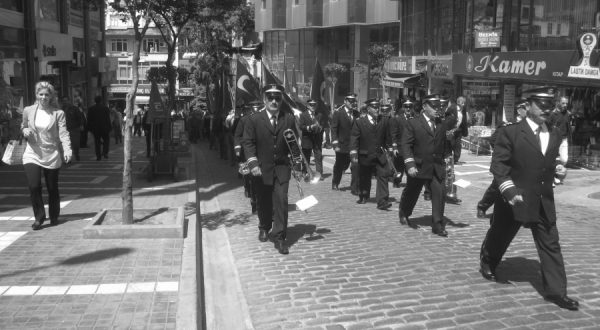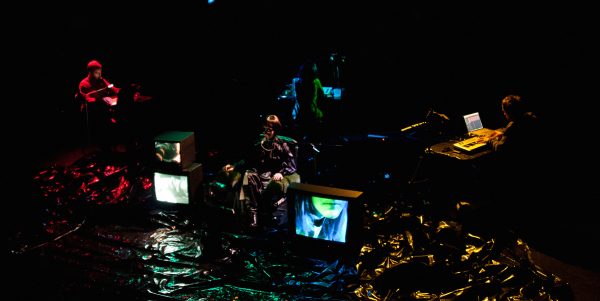I.
The first time I had to wear a uniform I looked like a madman struggling against a straitjacket. I wept so hard that my parents got scared. Mother became frustrated. ‘What is the matter with you?’ Father demanded. ‘You look so handsome in that uniform. Why don’t you enjoy it rather than cry like an infant?’
Changing into my first school uniform had made me self-conscious. I touched the fabric of this second skin with a sense of disgust. The white shirt, blue waistcoat, grey trousers and bow tie had stripped me of my self. I had morphed externally into someone else – one of those who work.
There was but one consolation: this was temporary. When I returned from school I would recover my identity. But the discovery of its instability troubled me. That day had marked the beginning of an almost lifelong difficulty. As children we become adults through the performance of dressing up, a ritual one cannot easily forget. Having adopted its disguise, can there be a self outside the uniform?
II.
In the last days of 2012, the Turkish government announced their decision to remove all uniforms from the country’s public schools. Politicians in Ankara seemed committed to lifting a regulation which had been planned during the first decades of the Republican era, without paying much attention to the socio-political consequences.
Generations of Turkish pupils have been educated in and through uniforms. Educational, military and social discipline have been maintained through their imposition. Many ex-students, like me, spent a significant portion of their lives learning how best to carry them. The uniform was the fundamental component of the school system, embodying a broader ideological programme that championed the concept of uniformity. Teachers asked us to appreciate the importance of acting in unison: they lectured us about the value of homogenisation. Turkey’s founding ideologues reformed the Turkish identity on the same principle, asking the country’s multiracial, multicultural population to willingly erase their heritage. Through this cultural amnesia the diverse national identity could be reconstructed as a homogenised, and therefore more governable, entity.
The uniform is both a symbol and a constitutive part of such an identity.
III.
That the national press turned the uniforms issue into a debate about Turkish identity and the nation’s self-image was not surprising. Some columnists expressed their pride in seeing the nation’s youth in blue uniforms while others looked forward to a new era where all students could dress as they liked.
Despite having defined me for so long, uniforms are no longer a personal issue for me. I am done with school; I have completed my military service; I am a doctor of philosophy—an academic status that does not require me to wear a uniform. As I followed the debate, the notion of the ‘Uniform’ slowly returned to its lexiconic essence, regressing to the abstract, impersonal thing the word signifies.
According to its opponents the bill, if made law, would violate the principle of equality. They argued that the equality provided by the school uniform was a value worth preserving; on the face of it this struggle for equality was a noble one. Nevertheless, it was strange to see this demand coming largely from the so-called ‘white Turks’—the country’s privileged classes who lead proudly ‘westernised’ lives while showing little interest in the traditional, ‘eastern’ values of Turkish society which they consider unenlightened and in need of ideological uniformity.
In my eyes those people were in part responsible for much of the country’s failings. For the last eight decades they had alienated and antagonised the pious and the Kurds, seeing them as their unenlightened ‘others’. They expected the country’s population to evolve into an enlightened citizenry devoid of any religious or ethnic affiliation. Uniforms represented this imaginary identity, championed by the school system, and served to whitewash social divides in the country while placating the population. The monolithic self-conception of the impersonal, undifferentiated Turkish identity is in perfect harmony with the imposition of the uniform.
So what becomes of this argument in favour of uniforms when we consider the equality they provide to be an illusive one? If equality itself is not in place in the wider social context, its superficial imposition by way of uniforms creates only the illusion of equality. The White Turks defence of uniforms amounted to the defence of an illusion.
IV.
Like numerous other aspects of modernity, uniforms first penetrated Turkish culture through the military. In 1829 Sultan Mahmud II introduced a law that specified details of the clothing of statesmen. This was part of his plans for modernising the military apparatus in areas where certain groups rebelled against his policies. As Donald Quataert argues in his article ‘Clothing Laws, State, and Society in the Ottoman Empire’, the phenomenon of state-imposed clothing was a manifestation of Mahmud’s will to control and reshape Ottoman society. The centrepiece of his sartorial vision was the fez, the traditional red hat made of kilim fabric. Fez got its name from the Moroccan city of Fes where it was produced in large quantities. That it came to represent growing westernisation in the Ottoman Empire is an interesting but logical phenomenon. The Sultan used the fez as a means of standardisation and uniformity, which he saw as the essence of western civilisation. If imposing the fez top-down on all soldiers was a repressive but also egalitarian measure it was because Mahmud saw the western civilisation in those terms. As a symbol of the modern, progressive ways of the west the fez effectively replaced the turban which the Sultan believed had represented the regressive chaos of the orient.
Mahmud’s attempt at dress uniformity was a first in the history of the Ottoman Empire which paved the way for the so-called Tanzimat (‘Reorganization’) period that followed, in which Mahmud’s sons tried reforming the state around ‘modern’ principles. As a signifier of modernity, the fez was a ‘homogenising status marker’, according to Quataert. It had paradoxically deleted identity while constructing it. As in modern day school uniforms, external homogenisation by no means meant social or political equality. Essentially it was an instrument that brought about centralisation.
One of Mahmud’s predecessors, Sultan Osman III, famously wandered among Istanbul’s streets to inspect the clothes of his subjects. Then there was Sultan Selim III who asked his advisers to use local textile in their dress—for him clothing was a matter of national pride. Neither of these rulers were as insistent as Mahmud who, according to Quataert, had introduced a revolutionary notion with his homogeneous dress which ‘specified that each civil official at every single rank (except for a handful at the very top) was to wear exactly the same headgear, the fez… Thus, all fez-wearing officials, be they kaymakams or clerks, would appear the same. The state’s use of clothing regulations to differentiate and reward as a means of enticing support and service and to demarcate among the many social and economic groups had foundered in the extraordinary messiness and confusion of the eighteenth century, when so many different groups had clamoured for social and political position and when the Sultan was merely one of many centres of power.’
The fez thus helped replace a chaotic, decentralised culture with a streamlined one. It strengthened the absolute authority of the ruler while forcing all Ottoman subjects to renounce their personal identities in the socio-political sphere. By introducing the 1829 law Mahmud had ‘reset the rules for differentiation’ and sought to reimpose his monopoly. Thanks to the function fulfilled by the uniform, the ruler had succeeded in making all subjects appear the same—the egalitarian illusion that helped cement his absolute power.
In the two centuries following Mahmud’s reforms, the symbolic and political potential of clothing was acknowledged by numerous political groups. To give but one example, a traditional cloth turned into the centrepiece of cultural clashes between Turkey’s secularists and conservatives when the state banned headscarves in the public sphere. During the 1990’s, Islamists and conservatives used headscarves as a symbol of their political struggle. For the secularists the headscarf was a uniform of sorts that destroyed a woman’s sense of individuality; for conservatives, on the other hand, a pious woman had the right to express her subjection to God through wearing a headscarf and it was perfectly possible to preserve her individuality while doing so.
Because the secular state considered the headscarf as a rebellion against its foundations young activists began seeing the headscarf as an essential component of their identity. The only headscarf-wearing parliamentarian in Turkish political history was Merve Kavakçi; in 1999 she attempted to enter parliament in her traditional dress and was forcefully evicted. In the fourteen years that followed no other parliamentarian dared to do the same.
V.
In On Ideology, Louis Althusser writes:
The reproduction of labour power requires not only a reproduction of its skills, but also, at the same time, a reproduction of its submission to the rules of the established order, i.e. a reproduction of submission to the ruling ideology.
I wore my first uniform for three years until the day I put it in a plastic bag. If you happened to be on the intersection of Rumeli and Valikonağı streets in Istanbul on that Friday afternoon, you would have seen me carrying the bag to a waste container. There was pleasure in watching the symbol of disciplined life disappear. Althusser had called school ‘an ideological instrument of state’ and my disposed-of uniform was now a remnant of that instrument. Unworn, the uniform revealed the performative aspect of our submission, the way in which ideology must be acted out.
People rarely remember the fate of their uniforms. I remember the önlük, that eerily simple state uniform I next wore; its apron-like, half-length black shirt that didn’t ask for gentleness, almost nothing staining its dark surface which seemed to envelope everything. The slim white collar, understood to be a symbol of the purity of the pupil’s character, was the only exception to the totalised uniformity of the önlük, similar to the nineteenth century turban which allowed soldiers more space for self expression. Our individuality was confined to that closely inspected strip which represented the extent and limits of our freedoms. I can now see a resemblance between this collar and the medals and decorations which became the new means by which hierarchy was established in the Ottoman culture after the introduction of Sultan Mahmud’s clothing policies. I also remember my military dress, that manifestation of total submission, the camouflage motifs making the uniform’s function crystal clear: to make you disappear. Living at the military base, my parents would visit me on a Sunday and look upon me with gleaming eyes.
I decided against throwing away this last uniform. To this day it remains in a closet in my apartment, witness to a lifelong, desperate struggle against uniformity that was perhaps doomed to fail from the beginning. As a passive piece of clothing it has defined me in numerous ways. It has directed my experience and it has subdued it. My inability to throw it away attests to the power the uniform still exercises on me.
*
A few months ago the minister of education announced that it would be up to schools to decide whether they wanted to impose uniforms or not. Parents would be advised about the matter, a sixty percent majority was deemed sufficient to make a decision. After this announcement participants of the debate sank into silence.




